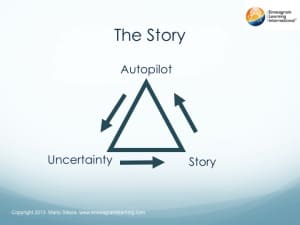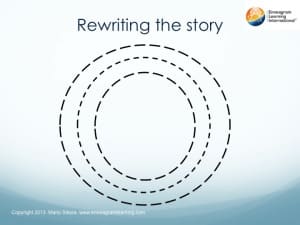
It’s easy to become so enamored with the descriptive power of the Enneagram that people skip over its most useful application–equipping us for change. But if we are only navel-gazing and obsessing over the details of description, we are doing little more than counting angels on the head of a pin. The value of the Enneagram is in its use as a model for change.
Most advice on how to change is very straightforward (and simplistic): Become aware of your patterns and what you need to do differently, then make a plan for doing the new behavior. I even see this among some authors giving this kind of advice to the various Ennea-types: “If you are a One, stop doing X and start doing Y…”
Of course, if it were that easy everyone would keep their New Year’s resolutions and the whole self-help industry would fade into irrelevance. Executive coaches like me would have to get real jobs…
We all know that change is not easy. The reason that most attempts to change fail is because they overlook a critical step between “become aware” and “act in a new way”—they fail to resolve the internal conflicts created by the attempt to change.
As Robert Kegan and Lisa Laskow Lahey point out it their work on immunity to change,1 attempts to change create competing commitments in our psyche. Intellectually, we know we should change and that the change would be good for us, but we also have an old narrative that tells us that what we are currently doing is also good for us in some way. The old behavior has the advantage of being comfortable and familiar, while the intended change is new and its value is not yet proven. Our internal narrative is that the old behavior has been effective, and changing will make us less effective in some way. The change we wish to make often seems to be in conflict with our narrative, and thus seems illogical. When we attempt to change, we face a conflict: we want to change but, deep down, the change doesn’t really make sense to us.
Kegan and Lahey point out that rewriting our narrative in a way that honors the existing commitment and the new commitment is the only way to overcome the inner conflict that causes our immunity to change. The beauty of the Enneagram is that it tells us exactly what those narratives are based on—nine adaptive strategies and our habitual definitions of them—making it easier to rewrite them.
Before exploring this further, let’s back up to see how these narratives take root.
Fortunately, we humans have a great ability to function on autopilot.
“Fortunately?” one might ask. “Shouldn’t we strive to be always present and awake? Shouldn’t we strive to always be Conscious and have Presence?”
Sure, we can strive for that, but it is very difficult to achieve it all day long. Life is complicated, filled with mundane tasks as well as complex activities that require our attention. In order to have time to think about the complex issues, we have evolved the ability to “outsource” the mundane to our internal autopilot. How much could we get done if we really had to be Conscious and Present when we were tying our shoes and brushing our teeth in the morning, feeding the dog, and packing the kids’ lunch, and didn’t allow ourselves to think about when we have to pick up our children from school and which event to taxi them to in the evening, the project due at work, what bills need to be paid, how we will deal with the care of our aging parents, or any of the other myriad of concerns that require our attention more than our shoelaces? It’s easy to practice Presence on the mountaintop and we can even do our best to practice awareness throughout the day; but much of the day for many of the things we do, we just need to trust our autopilot.
But while there many benefits, there are also downsides to this ability to be on autopilot–we sometimes miss our exit on the highway because our minds are elsewhere, we are lost in thought and forget our briefcase, we leave our dry-cleaning at the pre-school and our preschooler at the dry-cleaners…
When we realize that we have made one of these blunders, we are filled with a moment of anxiety or uncertainty (or downright terror, in the case of the dry-cleaning and preschool), and we immediately seek to create a narrative that resolves the situation in our mind and allows us to go back to functioning on autopilot. We “wake up” on the highway and are not sure how we got to where we are, so we look for signs or landmarks that help us locate ourselves; we remind ourselves that we are busy and we’ll find a way to function without the briefcase; we blame our wife for assuming we could manage two things at once… We eventually return to our zoned-out bliss, comfortable with our story.
This autopilot-uncertainty-story process is represented by the inner triangle of the Enneagram: the “going to sleep” represented at Point Nine, the fear represented at Point Six, and the self-deceiving personal narratives represented by Point Three. (See Figure 1.)

(Figure 1)
So, how do we change?
The inertia of habituated behavior is strong; our habitual narratives give us a sense (often false) of order and direction. Our narratives create immunity to change, and attempts to change that violate the logic of our narratives are rejected the same way the body rejects a transplanted organ of the wrong blood type.
The only way to change behavior over the long term is to change the narrative. However, we can’t simply abandon a narrative that has, in many ways, worked for us for much of our lives; we have to revise it so that it honors the past and our existing values while becoming more accurate given our current circumstances. We have to create a narrative that is more authentic.
The Enneagram can help us do just that, because it tells us what is at the core of our narratives–an adaptive strategy that shapes the way we think, feel, and behave. Unfortunately, that strategy is often defined in narrow and restricting ways; what was once adaptive can now be maladaptive. Attempts to change often conflict with the existing definition of the strategy and meet resistance. If we want to change, the only way we can make the narrative more authentic is to redefine our preferred strategy in more adaptive ways.
The steps to creating change are not simple “awareness” and “action;” if we want to change we must address the crucial middle step—”authenticity.”
Let’s look at an example.
One of the typical issues that my Ennea-type Three clients have to work on is their ability to develop and delegate to subordinates. Their preferred adaptive strategy2 is “striving to be outstanding.” They have an affective need to feel like they are high-achieving and meeting the high expectations they set for themselves and have internalized from others. This affective need makes them think in ways that have to do with how outstanding they are and how they can be more outstanding. The way they think shapes the way they behave and they try to behave in ways that will make them feel more outstanding. This, of course, is not the only motivation of Threes, but it is a strong one.
A common theme for my Three clients is that they rose to their level of success by being outstanding “doers”–working harder and faster than others, demonstrating superior performance. They are the classic achievers that David McClelland wrote about3–people driven to set goals and achieve them, to be admired by others, to fulfill (at minimum) the ideals of the community. Their habitual narrative is often rooted in an attachment to be seen as outstanding doers, and this can be their undoing as they rise to higher levels of leadership responsibility. Throughout their lives they have defined what it means to be “outstanding” as doing things better than other people. This narrow definition of the strategy has become calcified and rote. In their need to achieve they find it more satisfactory to do a task themselves rather than to take the time to teach others to do it and then delegate, even if this means that they end up with more and more work to do. The pattern becomes unsustainable as their responsibility grows and they can eventually burn out or fail to meet the commitments they have taken on.
It would be easy to say to these leaders, “Stop doing it yourself, develop your team and delegate to them.” If you did give them that advice, they would nod their heads and agree that it makes sense. They might even try it for a while. But quickly the inner conflict will undermine their efforts because the new behavior seems to undermine their narrowly defined implicit strategy. They will start to ask themselves, How can I perform better than others or strive for high standards of accomplishment if I take time out to teach other people how to do something? I will probably just have to redo it anyway because the other person surely won’t do it as well as I could have done it. Therefore, it just makes sense to do it myself.
Someone who does not have this same preferred strategy is working on a different model of logic and may easily see the flaws in this line of thinking. But each of us can get trapped by our narrative and be blind to what seems obvious to others.
In order to change, the Three leader must revise their narrative and rewrite the preferred strategy. In this case, they would recognize that their restrictive, calcified narrative is outdated and maladaptive and they would revise the strategy at its core to something along the lines of “Instead of being an outstanding doer, I will strive to be an outstanding leader. Outstanding leaders do the following things: develop people, delegate effectively so they can work at higher levels….”
If the Three can see that the change they want to make can help them actually satisfy a fundamental value (being outstanding), not undermine the value. When the strategy is redefined and the narrative rewritten in such a way, I find that the client actually wants to make the change and undertakes the action plan eagerly. The conflict between the inner commitments is resolved.
Taken together, the Awareness to Action Process (Figure 2) looks like this:

(Figure 2)
- Awareness: Pay attention. Recognize your habitual patterns. Set a goal for change.
- Authenticity: Identify the conflicting commitments created by the change. Rewrite your narrative by redefining the preferred strategy in a way that honors your values and makes the change attractive.
- Action: Create a simple and specific action plan. Deliberately practice the new behaviors to resist reverting back to old narratives.
- Repeat!
While the missing piece of most change efforts is found in the “authenticity” step, we must also realize that this is an ongoing activity. We can’t just rewrite the narrative once, since all narratives are limited and, by their nature, eventually become outdated. We should be constantly redefining the strategy—challenging our assumptions and dismantling our defenses and resistance, venturing farther from our traditional comfort zones. The word “authenticity” has the same root as the word “author.” Being authentic in this case means taking control of our narratives and being the author of our own lives; writing a story that is more aligned with our current reality than our habituated past.
Rather than allowing our narratives and our implicit definition of our strategy to remain calcified and bounded, we should constantly work on clarifying the definition of the strategy, making it permeable so that it gradually includes more and more possibilities. Sticking with the example of the Three Leader, constantly challenging and reshaping the implicit definition of striving to be outstanding eventually leads to a definition of “outstanding” that includes one who has let go of striving to be outstanding. This is the path to freedom from the grip of the calcified strategy.
It is at this point that people begin to fear that they are simply “feeding the ego” by working with the strategy instead of rejecting and working against it. I’m always puzzled by this; most spiritual and psychological literature tells us that the path to wholeness is through integration, rather than rejection of part of who we are. However, this approach just doesn’t seem “spiritual” enough to some people. A passage from A. H. Almaas’s “Diamond Heart, Book IV4,” addresses this issue nicely:
Embodiment becomes possible as the personality is clarified. The idea of clarifying the personality can be confusing because we often experience the personality as the source of our trouble. As we work on ourselves, we are constantly seeing the problems and suffering of the ego-ignorance, hatred, rage, fear, jealousy. So how, we wonder, can the personality be spiritual? It seems that the best thing we could do would be to obliterate it, to wage spiritual warfare, inner guerrilla warfare. In fact, many stages of the Work do feel like a kind of warfare. But successful warfare doesn’t mean destruction of the enemy, it leads, rather, to the annexation of the territory. This is often the original reason for warfare; it is actually a movement towards expansion rather than destruction.
The nine strategies are not innately good or bad. We may be tempted to judge the Three’s strategy of striving to be outstanding as egotistic, but who does not want to be outstanding at something, and why should we be ashamed of it? Why is it necessarily a bad thing? Do we judge the great painter or musician for being outstanding at their craft? Do we judge Ghandi or the Dalai Lama for being outstanding spiritual leaders? Do we criticize outstanding parents or teachers?
Of course not. It is the application of and attachment to the maladaptive uses of the strategy that is the problem, not the act of having a preferred strategy.
Yes, our implicit limited and calcified definitions of the strategy are often used in ways that cause us, and those around us, to suffer; it is a lens on the world that can easily become covered with mud and grime. But it is our nature to view life through some lens or adopt some strategy. It makes no sense to reinvent the wheel for each new circumstance; life is easier when we adopt a strategy that works for us and work on clarifying it rather than attempting to become “strategy free” in some way.
But we must continually polish and clean the lens; the strategy must serve us rather than us becoming a slave to it. While the implicit strategy is bound and calcified, treating it like clay or dough to be kneaded and stretched allows it to become permeable and frees us to use other strategies without feeling like we have lost something we can’t live without.
Over time, the strategy transforms from resembling a steel ring that restrains us to seeming like the expansive and fluid ripples on the surface of a pond (see Figure 3).

(Figure 3)
The outstanding doer becomes the outstanding leader as she understands that it is empowering others that leads to true greatness. She understands that the outstanding careerist can become the outstanding parent or spouse. It begins to take hold that the truly outstanding person is motivated by higher values than the perceptions and judgments of other people, and that the most outstanding person you can be is to simply be your authentic self.
Work with the Enneagram begins with working with the preferred strategy–simultaneously challenging it, embracing it and reclaiming it from the shadow, redefining it in adaptive ways that serve us rather than restrict us. Doing so allows us the flexibility and the freedom to go deeper in our work–to work on the other strategies in the same way,5 to practice the accelerators and nurture the core qualities, etc. (See Figure 4.)

(Figure 4)
Ignoring the “authenticity” step in the Awareness to Action process is to miss the whole point and to set ourselves up for failure on the path to change. Ignoring the long, hard work of the clarification of the strategy and rewriting of our narratives may make us think we are being more spiritual by somehow “rejecting” the ego, but it is actually just a “spiritual bypass.”6
We have to annex and integrate the territory, not ignore it, reject it, or try to destroy it. Change requires authentically working with the preferred strategy.
Visit Mario’s website at www.enneagramlearning.com.
1Kegan, Robert, and Lisa Lahey Laskow, Immunity to Change: How to Overcome It and Unlock the Potential in Yourself and Your Organization.
2The “preferred adaptive strategy” is the strategy we use the most. We don’t consciously prefer it, we do so habitually. We use all nine strategies to greater or lesser degrees, but one influences our thinking, feeling, and doing more than the others. “Striving to be outstanding” is placed at Point Three on the Enneagram, so we call someone who prefers that strategy an “Ennea-type Three.”
3http://en.wikipedia.org/wiki/Need_for_achievement.
4Accessed online December 23, 2014 at http://webcache.googleusercontent.com/search?q=cache:jdHEHwQXCL8J:www.ahalmaas.com/system/files/BAhbBlsHOgZmIiQyMDEzLzAyLzA4LzA1LzI3LzIwLzgyMy9kaDQucGRm/dh4.pdf+&cd=1&hl=en&ct=clnk&gl=us.
5I find that the more we work on our preferred strategy, the more quickly we can make progress on the other eight strategies, as if we get a lot of the prep work done on the first strategy and are less defended and attached to the others.
6“Beware of Spiritual Bypass” by Ingrid Mathieu, Ph.D. accessed online December 23, 2014 http://www.psychologytoday.com/blog/emotional-sobriety/201110/beware-spiritual-bypass)

